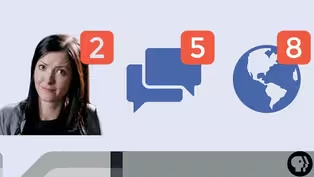
The Psychological Tricks Keeping You Online
Season 4 Episode 31 | 9m 41sVideo has Closed Captions
We take a look at persuasive design – and how good design persuades you every single day.
We take a look at persuasive design – and how good design persuades you every single day. When it comes to technology this can have some pretty big impacts of keeping us hooked to our devices. Should navigating this be your responsibility? Or should we call for more ethical design?
Problems playing video? | Closed Captioning Feedback
Problems playing video? | Closed Captioning Feedback

The Psychological Tricks Keeping You Online
Season 4 Episode 31 | 9m 41sVideo has Closed Captions
We take a look at persuasive design – and how good design persuades you every single day. When it comes to technology this can have some pretty big impacts of keeping us hooked to our devices. Should navigating this be your responsibility? Or should we call for more ethical design?
Problems playing video? | Closed Captioning Feedback
How to Watch BrainCraft
BrainCraft is available to stream on pbs.org and the free PBS App, available on iPhone, Apple TV, Android TV, Android smartphones, Amazon Fire TV, Amazon Fire Tablet, Roku, Samsung Smart TV, and Vizio.
Providing Support for PBS.org
Learn Moreabout PBS online sponsorshipMore from This Collection
We’re in the middle of an Attention War – where big tech battle it out to win over our eyeballs. Our attention spans are considered a precious—and scarce—commodity. So what is the price of your attention? In this mini-series, we'll explore the psychology, design and impact of tech and social media on both ourselves and society. A new episode will be released every Friday for the next six weeks.
The Attention Economy Needs to Change. But How?
Video has Closed Captions
So... Could you run Facebook better than Zuckerberg? (10m 59s)
Video has Closed Captions
The emerging monetization of your emotions. (10m 1s)
How One Company Redefined Social Norms
Video has Closed Captions
Facebook's impact on society – how it's changed mass grief and other social norms. (10m 1s)
Big Tech's Battle For Our Attention
Video has Closed Captions
So, what's the price of your attention? (11m 36s)
Providing Support for PBS.org
Learn Moreabout PBS online sponsorshipIn every small action you make throughout your day, there’s an illusion of choice: that you’re acting however you like.
Though if you look through a different lens, you can see that your world has been designed for you to interact with it in a certain way.
Take this cup, for example.
I use it so effortlessly.
But what about this one?
It’s obviously terrible!
Good design is one that you don’t even notice.
Because designers predict how humans intuitively interact with objects and design them with a cue that leads to an action.
And the same principles are true in the digital world.
A ding is to grab your attention.
The colour red is to alert you.
A notification is to click.
Just like everyday objects, our devices are designed with our psychology in mind.
But they seem to be pushing it too far.
Technology plays psychological tricks on you… every single day.
Most objects – like a toothbrush – are designed specifically to help me easily use them to reach my goal.
After their job is done, they go away.
A door’s goal is to let you through, a cup’s goal is to let you drink, a phone’s goal is to let you talk, but what is Facebook’s goal?
In this case, the goal of a company may not be in line with the goal of you, the user.
Facebook and I, for example, agree on one thing: helping me stay connected with my social circle.
But Facebook, arguably, has another goal: keeping me online as long as possible, to increase time on site and increase ad revenue.
Imagine if other common tools kept you using them indefinitely.
Yet, I check my phone 100 times a day, according to an app I recently installed that tracks how often I check emails, Instagram, Twitter and so on.
And I wouldn’t say that spending 25% of my waking life on my phone is one of my goals!
Yet studies suggest most other people also average at that number.
And it’s making them unhappy and distracted.
“Well, according to facebook's own published research by their own researchers that they're paying the service makes people sad.
It makes people anxious.
According to other researchers, it increases suicide, especially in people going through puberty, uh, teenager's.
According to other research it increases, uh, ethnic and societal division, tensions and warfare and violence in many parts of the world…” Then why don’t we throw our phones out the window and deactivate our social media accounts?
Some people like to blame our collective tech addiction on personal failings, like weak willpower.
But others, a growing number of tech designers are now arguing that it’s the software itself that’s to blame.
“The very people who have designed these systems have often come out years later saying we deliberately used addictive algorithms.
Sean Parker, first president of facebook has said this.
So this is not really a matter of paranoid interpretation.
This is simply restating what has been said on the record by the people who created the systems.” Now this is called persuasive design.
It can keep you hooked – but some tech designers say this is beneficial.
“So all sorts of habit forming products both offline and online, uh, use these persuasive design principles that I've encapsulated in this model called the hooked model, which has these four basic steps of a trigger, an action, a reward, and finally an investment.
And it's not just our technology that use this model, all sorts of products.
What makes a television show interesting or a book a memorable read or what makes you want to watch a movie or sports match the same exact psychology that's used to make anything engaging is also used in these devices that we use everyday to keep us scrolling and checking in and reading.” These principles were born out of Stanford’s Persuasive Technology Lab, founded by BJ Fogg.
And they started out quite innocently.
The idea was to use technology to drive positive behaviour, like, to quit smoking or pick up exercise.
“What is it that makes a behaviour become automatic?
In other words, become a habit?"
I think Fogg, his biggest contribution was that he was kind of the catalyst for a lot of folks in the industry coming together at the right time and right place.
So the Fogg model basically says b equals mat: motivation, ability and a trigger are the drivers of behaviour.
Notice by the way, that the user has to have some kind of motivation.
This is incredibly important because there's a big difference between persuasion, which is helping people do things they want to do, where they need some amount of motivation and coercion.
Coercion is always unethical, right?
This is persuasive design, not coercive design.
Let’s take a step back and consider how this persuasion – the motivations and triggers – can play out in your everyday experience online.
Let’s say, in the context of you watching this video, you might become motivated to share this knowledge with your friends to look smart.
Now I can prompt you to tweet out this video.
“Perhaps, you’d like to take a moment to share this with your friends.
Go on” There’s your trigger.
And to increase your ability, I can make it all easier by even providing some suggested text and a link [link appears on screen.
A prompt to tweet or open a notification seems simple enough.
But they also serve as a cue that leads to an action of us falling down a YouTube rabbit hole or spend hours zombie scrolling on Instagram.
These triggers change our behaviour patterns.
“Well, if you put a rat or a dog or a person in a cage and you can observe exactly what they do, you can use algorithms to change their behaviour patterns.
You can get them addicted to pressing a button over and over again for candy.
You can get them to change their ways.
It's, it's a science that's been studied for centuries now.
It goes back to the 19th century” This is not a newly understood phenomenon.
It comes straight out of classical psychology.
We develop a special relationship to things that we associate with pleasure, even if the momentary feel-good pleasure of a notification.
Remember Pavlov’s dogs?
In the 1890s, Russian physiologist Ivan Pavlov discovered that if he rings a bell every time he feeds the dogs in his lab, they would begin to salivate at the sound of the bell, even without any food in sight.
The dogs’ brains had paired a neutral stimulus, the bell ring, with an involuntary behaviour, salivating.
This is classical conditioning and it explains why when we hear a phone chime we reflexively reach out to our phones.
But a notification is not always something you’re glad to see.
This makes the reward unpredictable, making it all the more alluring to keep looking for it.
This phenomenon is called operant conditioning.
It is the most effective way of forming and maintaining a behaviour.
It’s also the basis of addiction.
Many of us may not need to commit to a rehab clinic.
But still, our digital behaviours can have large impact on our lives.
And this impact isn’t always helpful.
In mid 2018, Technologist James Williams asked, “Who would continue to put up with a GPS that they knew would take them somewhere other than where they wanted to go?
... No one would put up with this sort of distraction from a technology that directs them through physical space.
Yet we do precisely this, on a daily basis, when it comes to the technologies that direct us through informational space.” We tolerate being mislead through our information space because, when our technology is designed well, we don’t even notice.
Now: Is this just good design and your responsibility to navigate… Or are we being manipulated?
I think the better approach here is to recognise that nobody fully understood what was happening as we got into this problem.
Some people understood a little sometimes and a little more as time went on.
Um, I do think personal responsibility is the way forward and that's why people should delete their accounts to learn about themselves.
For most of us, unplugging entirely is almost never an option.
But we can recognise the design tricks and reverse them.
Remove the triggers – like turn off push notifications.
Reduce your ability – so delete apps you don’t really need.
Or put your phone out of reach.
And think hard about your motivation: direct your attention to what you really care about.
The same methods that make Snapchat addictive, help you learn new languages on Duolingo.
The same thrill of endless swiping of Tinder also exist in this app, Find Shadow, that’s for finding lost dogs and returning them to their humans.
Which app you open is your choice.
We can all be more mindful about how we use technology.
Because, If we’re just left to our own devices, any of us can become that dog... staring at the screen because a bell can ring at any second.
Now if I still have your attention, this is the second episode in a six part quest in understanding the psychology of attention, persuasive design and how we can all have a healthier relationship with technology.
I do hope you’ll join us, in your own time, at your own pace, to consider the impact tech


- Science and Nature

A documentary series capturing the resilient work of female land stewards across the United States.












Support for PBS provided by:





